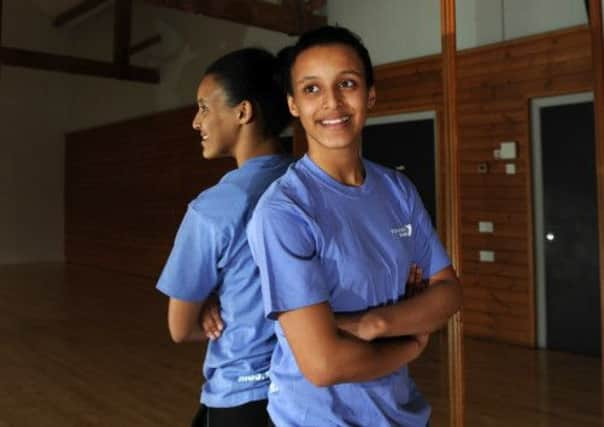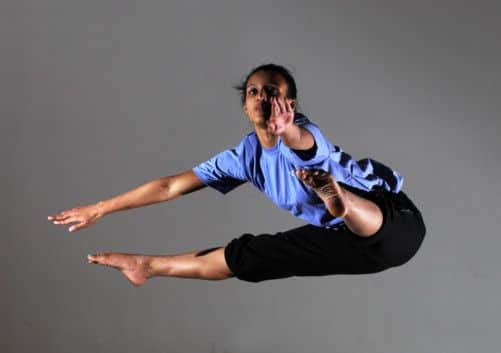Charlie feels the power of dance


For many people Kes is the ultimate Yorkshire story. Based on Barry Hines’s A Kestrel for a Knave, it is the tale of a boy whose outlook and options in life are bleak. He finds escape through his relationship with a soaring kestrel.
It’s hard not to be reminded of that life-affirming story when you meet Charlie Buchanan.
Advertisement
Hide AdAdvertisement
Hide AdCharlie, it’s fair to say, comes from a similar world to that young Billy Casper occupies in Kes. Her options are limited. At least, they might have been, had she not discovered dance.


“I can express myself when I dance,” says Charlie. “You don’t have to be good at maths or English, you don’t have to have a lot of money, you don’t have to be all skinny. There are no right or wrong answers. With dance it’s just about feeling the music. In life there are a lot of times when the answer’s either wrong or right, like in exams. But in dance it’s not like that.”
Charlie is 16 and her options, now, are wide open. Spend five minutes in her company and you too would be convinced that she, alone, is reason enough for Yorkshire Dance to receive the funding it gets from the Arts Council.
Charlie, however, is not alone. She is just one of literally thousands of people Yorkshire Dance has worked with, inspired, assisted, facilitated – call it what you will – in its 30 year history.
Advertisement
Hide AdAdvertisement
Hide AdThe Leeds-based dance agency recently celebrated its 30th anniversary with a major celebration at the Quarry Hill headquarters. It was certainly a landmark birthday, but the story of Yorkshire Dance is much more about those like Charlie than it is about one date in the calendar.
Charlie is a beneficiary of Yorkshire Dance’s community commitment, one of the company’s three main strands. Two-and-a-half-years ago Yorkshire Dance decided to specifically target two areas of Leeds – Seacroft and Richmond Hill.
“We made an ongoing commitment to work in those areas because they happen to be two of the most deprived areas of the city and they are right on our doorstep,” says Wieke Eringa, chief executive and artistic director of Yorkshire Dance. “We don’t have the resources to work with the whole of Leeds, so we decided to concentrate on working with those two areas.”
The agency started running dance classes and Charlie joined the sessions in Seacroft, the neighbouring suburb to her home in Gipton. Within the first term three of the women who had joined the class fell pregnant and many were smokers.
Advertisement
Hide AdAdvertisement
Hide AdEringa says: “At the end of the term two of them had stopped smoking, some of them had performed at the West Yorkshire Playhouse, others had been involved in the Olympic Torch Relay and at least two of them now want to make dance a serious part of their lives in the future.”
There are a lot of Charlie Buchanans out there, whose options were limited – and whose options have become much, much wider thanks to dance.
“It’s not just a way of escaping, or expressing myself, it helps with my studies. If I’m, struggling or something, I can dance and then go back feeling refreshed,” says Charlie. “If I hadn’t discovered dance then I don’t think my GCSEs would have come out as good as they did.”
Charlie’s GCSEs were good enough for her to now be studying A-levels and she has one eye on a future at university and a career in dance – and not necessarily in performance – she has discovered, through Yorkshire Dance and work experience with the organisation in the offices, that there are many facets where her skills could be put to good use.
So what is Yorkshire Dance?
Advertisement
Hide AdAdvertisement
Hide AdThe idea of creating a dance agency for Yorkshire was conceived by Dr Janet Adshead of Leeds University and Jean Tallantire of the Sports Council. A grant from the Sports Council in 1982 made the idea a reality and Councillor Bernard Atha, then chair of recreation and leisure at Leeds City Council, and later to become chair of Yorkshire Dance’s board of directors, secured studio space for the newly-formed company in Leeds Grand Theatre.
Within a few years it had moved into a derelict textiles warehouse at Quarry Hill. The area is now home to the Leeds College of Music, West Yorkshire Playhouse, Northern Ballet and the BBC. It is known as Leeds’ Cultural Quarter. Yorkshire Dance’s home is a four-storey building with three fully equipped dance studios and a number of other arts companies as tenants.
The organisations exists, broadly, to promote dance across Yorkshire.
Aside from the community engagement, the organisation also supports artists to create sustainable careers and work and advocates for dance.
Advertisement
Hide AdAdvertisement
Hide AdEringa is a formidable leader. A 6ft Dutch native she took over Yorkshire Dance when it was teetering. The Arts Council had made it clear that the organisation had to work harder for its funding and it had to start making its funding work harder.
Over the last few years Eringa has led the team to success. How much success? When the Arts Council funding cuts of last year were announced, Yorkshire Dance was one of the few organisations that won itself an uplift in funding. The reason it is such a boon that Yorkshire Dance is healthy right now is because the country is ripe to accept the artform. Last year’s Olympics, thanks not only to Danny Boyle and his stunning opening ceremony but to the way culture was put at the centre of the celebrations, demonstrated why Britain remains a world leader in terms of the arts. Contemporary dance figured large in much of the celebrations.
“The dance element of the opening ceremony helped to put contemporary dance in the mainstream,” says Eringa. “We also saw initiatives like Big Dance running all over the country which put contemporary dance in the regions – there were 10,000 people taken part in dance events in Yorkshire and they were watched by 66,000 people. As an artform, the popularity of dance has been increasing massively over the last 10 years, with programmes like Strictly Come Dancing and the Olympics really capitalised on that.”
Eringa is not someone who can be easily pushed into saying something she doesn’t believe and so stops short of saying the Yorkshire Dance needs to strike while the iron is hot. The organisation’s work is much more slow burn for her.
Take Gary Clarke and Charlotte Vincent.
Advertisement
Hide AdAdvertisement
Hide AdThey are both important names in the world of contemporary dance. Even if you have no interest in that world, you will be able to appreciate that having people from Yorkshire who are recognised as top in their fields is good for all of us.
Eringa says: “One of the key things we do is support the development of the art form. Gary Clarke has a national reputation and very soon he won’t need us at all. Charlotte Vincent is the result of 15 years of development work with Yorkshire Dance.
“We work with artists to develop their business skills, work with them on funding applications. With people like Gary and Charlotte, it’s difficult to say that they wouldn’t be doing dance if it wasn’t for us, because they are just too good. I am confident that they wouldn’t be doing it here in Yorkshire. When you have five-and-a-bit million people in a place, some of those people will have a talent for dance and without us to help them, they might end up going somewhere else.”
When we meet Eringa arrives from one of the building’s three dance studios and as she arrives, exclaims: “I’ve just been upstairs watching the next Gary Clarke. It’s a young boy who’s made this exceptionally powerful piece.”
Advertisement
Hide AdAdvertisement
Hide AdBut it’s not just those major talents that the organisation is there to support. The St Peter’s Square building also hosts dance classes. “At last year’s celebration, the dance participants ranged in age from eight to 82,” says Eringa.
“We work with people with learning difficulties, with minority women’s groups – maybe it’s idealist, but I like to see something like that, that is representative of our own community in Leeds and the people that make up that community being beautiful in their own bodies and being empowered by dance.”
Charlie understands that view.